

| 2 Morpho-Phonology | 7a Using Affixes | 12 The Number System | |
| 3 Basic Morphology | 7b Using Affixes (continued) | The Lexicon | |
| 4 Case Morphology | 8 Adjuncts | Revised Ithkuil: Ilaksh |
| 11.1 A “Morpho-Phonemic” Script |
| 11.2 Number of Characters |
| 11.3 Physical Design of the Characters |
| 11.4 How the Script Operates |
| 11.5 Character Lists |
The Ithkuil writing system, like the language itself, although
extremely complex in its structure and usage, is strictly logical and highly
efficient in its ability to convey information. In previous chapters we have
seen the high degree of detail and multi-level functionality and dynamism inherent
in the language’s morpho-phonology, morpho-syntax, and lexico-semantics.
The workings of the Ithkuil writing system are no different. For example, just
as the consonants and vowels of nominal and verbal stems can mutate into new
forms, so, too, do the characters of the Ithkuil script mutate into other forms
based on morpho-phonological rules.
Such dynamism in a language’s writing system can be achieved because the Ithkuil script has the unique distinction of being “morpho-phonemic,” i.e., the individual characters of the script do not merely convey phonemic content like an alphabet or syllabary, but also convey morphological (grammatical) information. Additionally, the phonemic and grammatical information conveyed by a specific character changes depending on the position of that character within a word. This dynamism allows individual Ithkuil words to be written with a fewer number of characters than in alphabetic or syllabic writing systems, particularly those words which are highly inflected and/or have multiple affixes. As a consequence of such a system, however, it is impossible to learn how to write in the script unless and until one is first familiar with the grammar of the language. As an example, the following diagram presents an analysis of the phonological and grammatical information contained in each written character of the following Ithkuil sentence:
|
|
|
|
|
|
|
|
|
|
|
1 |
2 |
3 |
4 |
5 |
6 |
7 |
8 |
9 |
|
1 |
Consonantal character, Grade 1, alternate form. Word-initial position implies C1 phonemic Value = /l/. Alternate form shows word carries ultimate stress. Phonemic value in conjunction with position preceding a personal reference adjunct infix indicates word is a single-referent personal reference adjunct. | |
|
2 |
Personal Reference Adjunct infix character. Values: AFFECTIVE Case; Affix Degree 1. | |
|
3 |
Consonantal character,
Grade 1, primary form. Position immediately following a personal reference
adjunct infix implies C2 phonemic Value = / |
|
|
4 |
Character is a composite aspectual adjunct infix character with following values: INTUITIVE validation; ALLEGATIVE sanction. Position relative to previous characters indicates that it is part of a different word. | |
|
5 |
Vocalic character /â/, Series A, primary but hook-reversed form. Position immediately following an aspectual adjunct infix character indicates start of new word. Position preceding two consonantal characters indicates word is a formative. Primary form indicates NORMAL essence. Hook-reversed form indicates a Form II stem, i.e., FORMAL designation. Absence of dot diacritic indicates word carries falling tone. | |
|
6 |
Consonantal character, Grade 1, primary form. Phonemic value: /q/. Position following vocalic character and preceding another consonantal character indicates it is a C1 radical. Adjacent “wedge” diacritic, in absence of similar diacritic on either the preceding vocalic character or the following consonantal character indicates STATIVE conflation. | |
|
7 |
Consonantal character,
Grade 1, primary form. Phonemic value / |
|
|
8 |
Consonantal character, Grade 5, primary form. Position following a C2 radical indicates a consonantal affix. Phonemic value /q’/. Grade 5 = affix-degree 5. Absence of diacritic indicates affix-type 1, non-geminated. | |
|
9 |
Consonantal character, Grade 5, primary form. Position following a C2 radical indicates a consonantal affix. Phonemic value /d/. Grade 5 = affix-degree 5. Absence of diacritic indicates affix-type 1, non-geminated. |

‘I feel that nowadays everyone everywhere is happy.’
_Listen!
Notice how the above analysis shows that the only purely phonemic
information given by the Ithkuil written characters in this sentence is for
/l/, /![]() ’/,
/â/, /q/, /
’/,
/â/, /q/, /![]() /,
/q’/ and
/d/. All remaining information represented by the characters
is wholly morphological, by which the reader “constructs” the pronunciation
of the sentence as a whole. Such is a morpho-phonemic script.
/,
/q’/ and
/d/. All remaining information represented by the characters
is wholly morphological, by which the reader “constructs” the pronunciation
of the sentence as a whole. Such is a morpho-phonemic script.
It is important to recognize that while the phonological component of the Ithkuil script gives information as to the phonemes associated with the stem and affixes of a noun or verb, it does not operate alphabetically to tell the reader the specific pronunciation of a word. The reader must be familiar with the grammar of the language in order to know how to interpret the phonological component of the script (including the possibility of allowable alternative pronunciations or transliterations). This morpho-phonemic principle can be illustrated by showing how affixes to a noun or verb are represented in the script. The Ithkuil translation of the English sentence I am a sufficiently large man can be said in all of the following equivalent ways, due to the flexibility of Ithkuil affixation rules (see Sec. 6.5):
Ta yâqomüxduï.
Ta yâqomüxiäd.
Ta yâqomduïxü.
Ta yâqomiädüx.
Ta xü’a yâqomiäd.
Ta duï’a yâqomxü.
Ta duï’’üx yâqom.
Ta xü’’iäd yâqom.
Even though there are eight possible ways to say this sentence in Ithkuil, they are all written the same, as shown above. This is because the script does not indicate specific choices of alternatives in the position of morphemes (phonological units having a particular semantic or grammatical function). The first symbol of the phrase above indicates the initial consonant element t- of the personal-reference adjunct tawa (or ta), while the second symbol conveys OBLIQUE case for the adjunct, interpretable as -a or –awa. The third symbol represents the vocalic prefix â-, as well as the form, tone, mode, and vocalic mutation series of the stem. The fourth and fifth characters represents the C1 and C2 consonants of the root respectively, along with the mutational grade, stem number, vowel pattern, syllabic stress and conflation information which transforms the initial â- prefix to yâ-. The last two characters represent the two affixes including their degree and affix-type.
It should be noted what the written form of this word does not convey. It does not tell us what vowel is to be infixed between the C1 and C2 consonant consonants (as this is predictable based on the form, set, mutation series and vocalic pattern), it does not tell us whether or how to pronounce the affixes as suffixes or prefixes to the stem or in adjunct form, nor in which order to pronounce them. Consequently, the script functions more like a template or code for the basic phonemes of roots plus the grammatical information necessary for a speaker of the language to interpolate these into actual spoken words. Note also that there is no space between the two written words, as the third character, being a vowel character following a specialized adjunct character, automatically indicates the beginning of a new word.
While such a multi-functional system of writing is extremely complex and impossible to use without a thorough understanding of Ithkuil morpho-phonology and morpho-syntax, it makes for a very abbreviated written representation of words, in that all parts of a spoken word whose phonological component is predictable from the grammar, need not be written, while those parts of a word which are not predictable can be represented by symbols which convey much more than a sound, but rather also convey the grammatical information necessary to construct the unwritten parts of the word. As a result, the script acts to “compress” the written form of the language as opposed to the spoken form, much like computerized “compression” software stores computer files in a space-saving manner in which all components of a file whose construction is predictable based on other components, can be eliminated in the stored version, and restored when accessed. Similarly, the “compressed” form of words in the Ithkuil written language are restored to full pronunciation when spoken or read.
The script is based on 252 core characters used to write both formatives and adjuncts, plus 54 specialized combinatory elements used only with adjuncts. Of the core characters, 48 of these represent vowel elements, 60 represent consonantal elements, and 84 represent characters associated with valence/version adjuncts. Each of the 48 core vowel characters has three modified variants for a total of four variations, each of which then mutates into eight other characters for a total of 864 vowel symbols. Each of the 60 core consonant characters has one alternate version, this alternate and the original both mutating into eight other forms for a total of 1080 consonant characters. The 54 combinatory elements are divided into two sets of 27, each set comprised of three subsets of nine components. A single component of each subset combines with a component from the other two to render a tripartite composite, rendering a total of 789 possible composite characters for each of the two sets. Combined with the 2028 variations and mutations of the core characters, this renders a grand total of 3606 characters. Additionally there are a few symbols which correspond roughly to punctuation marks. A further set of numerical symbols will be discussed in Chapter 12.
The physical form of the characters in the script is based on two different types of written strokes: straight “bar”-like elements, and pointed sickle-like “hooks.” These bars and hooks are joined to one another in a variety of angular “offset” connections. While there can be a number of different bar-like elements comprising a given character, only one arc or hook can occur in a character. These bars and hooks can be easily discerned in the sample of Ithkuil writing shown here.
The four primary character archetypes of the Ithkuil script
are as follows: ___![]()
These can then be turned upside down, combine with each other, and have their lines bent at angles to generate additional secondary archetypes:
From these archetypes, the thousands of remaining characters are derived. Examples of some of the various patterns of derivation are shown in the chart below:
Up to this point example phrases and sentences in this work have shown the script written in what appears as a familiar left-to-right horizontal style. However, such a format is used only for brief autonomous phrases or sentences which take up a single line. Similarly, the individual Ithkuil characters themselves are normally written in this horizontal fashion when listed by themselves as in the various tables throughout this chapter.
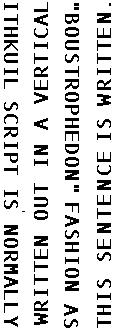 |
For passages taking up more
than one line, as in general narrative passages or “paragraphs,”
the script is normally written in a vertical boustrophedon fashion
(Greek for “as the ox plows”); specifically, it is written
in vertical columns starting at the upper left of a page, with the first
column being written top-to-bottom and each character oriented sideways
and opening downward, then reversing direction in the second column and
being written bottom-to-top with each character facing or opening upward.
Each line continues this “zig-zag” approach from the left
side of the page to the right, every other line running one direction
as opposed to the preceding and following lines. This is illustrated by
analogy with Roman letters to the left and can be seen in the sample of
an Ithkuil passage below. |
 |
TRANSLITERATION: TRANSLATION: |
As previously stated, writing Ithkuil requires a knowledge
of both the morpho-phonological and morpho-syntactical rules of the language.
Recall that Ithkuil has two parts of speech: formatives and adjuncts. The rules
for writing formatives are separate from the rules for writing adjuncts. We
will first examine the rules for writing formatives.
As described in Chapter 2, formatives derive morphologically from a stem of the form C1ViC2, where C1 is one of 60 consonantal radicals, C2 is one of 60 consonantal radicals, and Vi is a vocalic infix determined by the Form, Pattern and Stem. Specifically each abstract semantic root generates three Stems within two Modes, and each Stem in turn has two Forms and three Patterns. For convenience, the following table, originally shown in Sec. 2.2.3 is repeated here to illustrate these relationships.
Table 35: Vocalic Infixes for Stems by Mode, Pattern & Form
| Primary
Mode |
Secondary
Mode |
||||||
| Pattern
1 |
Pattern
2 |
Pattern
3 |
Pattern
1 |
Pattern
2 |
Pattern
3 |
||
Form
I |
stem
1 |
a |
e |
ä |
aî |
eì |
aì |
| stem
2 |
u |
o |
ö |
uî |
oi |
uì |
|
| stem
3 |
i |
ë |
ü |
eî |
oì |
ëì |
|
Form
II |
stem
1 |
â |
ê |
ae |
aû |
aè |
aù |
| stem
2 |
û |
ô |
ø |
oû |
où |
ëù |
|
| stem
3 |
î |
ÿ |
iu |
eû |
eù |
iù |
|
As shown in the above table and described in detail in Chapter 2, it is the vocalic infix of a formative, not the consonantal radicals that convey and differentiate the morphological components of Mode, Pattern, Form and Stem. However, the Ithkuil script does not overtly represent symbols for this vocalic infix. An Ithkuil formative (not including suffixes) is represented by three characters: an initial vowel character whose phonological component represents the initial Affiliation/Extension prefix (see Sec. 3.4), plus characters representing the C1 and C2 characters. Therefore it is these three characters which, in addition to their phonological component, must convey the above-named morphological components, additional morphological components of Focus and Conflation, as well as additional phonological information such as tone and stress. The following paragraphs describe how the Ithkuil script accomplishes these tasks.
11.4.1.1 Representing C1
Consonantal Radicals. Distinct written symbols exist for each of the
60 C1 consonantal radicals. Just as each C1
radical can mutate into one of eight other forms for a total of nine mutational
grades (see Sec 2.4), so these
60 written characters can be mutated into eight other characters, each corresponding
to the nine mutational grades. This is illustrated below for the C1
radical ![]() .
.
Standard Forms

Additionally, each C1 symbol pattern
has an alternate pattern, used under certain morphological circumstances described
later. The alternate pattern for the C1 radical
![]() is illustrated below.
is illustrated below.
Alternate Forms

Note the similarity of these alternate forms to the standard
forms. In the case of the C1 radical ![]() ,
the alternate pattern is shown by a mere point-like extension at the base of
each character while the rest of the pattern remains identical. For all consonantal
characters, the nine grades of mutation are differentiated by variations in
the top “half” of the character, while alternate versions of characters
are shown in the bottom half of the character. For example, compare the standard
and alternate forms of
,
the alternate pattern is shown by a mere point-like extension at the base of
each character while the rest of the pattern remains identical. For all consonantal
characters, the nine grades of mutation are differentiated by variations in
the top “half” of the character, while alternate versions of characters
are shown in the bottom half of the character. For example, compare the standard
and alternate forms of ![]() above with those of the C1 radical k
above with those of the C1 radical k![]() below.
below.
Standard Forms

Alternate Forms

For formatives, one of these 120 symbols (the 60 C1 radicals and their alternates) or their eight grades of variants will always constitute either the first or second symbol of a word. For those formatives where it is the second symbol, the first symbol will always be a vowel character. Vowel characters are distinguished from consonantal characters because the former always contain a sickle-like “hook” element while consonant characters do not. Consequently, it is always possible to tell which is the C1 symbol of a formative.
11.4.1.2 Representing C2 Consonantal
Radicals. As for symbols denoting the C2 consonantal
radical, they are the same 60 symbols (plus alternates and eight grades of variants)
used to represent C1 forms, however they do not necessarily
represent the same phonemic values as when used for C1
forms. If we compare Tables 6 and 7 in Section
2.4 we see that of the 60 C2 radicals in Grade 1,
only 24 of them can also be C1 radicals, and even these
24 mutate in a completely different manner than their C1
counterparts. In other words, the same written symbol often represents completely
different consonantal forms, depending on whether it is being used to represent
a C1 radical or a C2 radical. Thus,
for example, the written symbol for k
in Grade 4 will be interpreted as ![]() if representing a C1 radical, but must be interpreted
as sk if representing
a C2 radical.
if representing a C1 radical, but must be interpreted
as sk if representing
a C2 radical.
So how is the reader supposed to know if it is a C1 versus C2 radical being represented? By the position of the symbol in the word, i.e., whether it is the first consonantal symbol in the word (indicating it is C1) or whether it is the second consonantal symbol in the word (indicating it is C2). The second consonantal symbol in a formative will always represent one of the nine grades of a C2 consonantal radical. Let us illustrate this principle by examples.
Note how it is mere position within the word that distinguishes the interpretation to be given to what are otherwise identical written symbols, allowing six phonologically different radicals to be represented by only three different symbols. In this manner, Ithkuil can make do with symbols for C1 radicals without requiring separate symbols for C2 radicals.
As for those C2 radicals in Grade 1 that
do not correspond to any C1 radicals in Grade 1 (i.e.,
b, d, ![]() ,
g,
,
g, ![]() ,
j, v,
,
j, v, ![]() ),
Ithkuil represents these using C1 symbols as well. They
simply have completely different phonological values than for their usage as
C1 symbols. As an example, the C1
symbol for šp
becomes the symbol for r
when representing a C2 radical. Again, it is mere position
in the word that clues the reader into interpreting the symbol as a C2
radical, rather than C1.
),
Ithkuil represents these using C1 symbols as well. They
simply have completely different phonological values than for their usage as
C1 symbols. As an example, the C1
symbol for šp
becomes the symbol for r
when representing a C2 radical. Again, it is mere position
in the word that clues the reader into interpreting the symbol as a C2
radical, rather than C1.
11.4.1.3 Representing Pattern and Stem. The three Stems and three Patterns associated with each root are shown by a specific pattern of diacritic dots on the two radical consonants of the stem. This diacritic pattern is distinguished both by the selection of which consonantal radical is marked, as well as whether the diacritic is placed below the character or alongside. This is illustrated in the table below.
Table 36: Diacritic Markings
for Displaying Pattern and Stem

11.4.1.4 Representing Stress. The four stress patterns (see Sec. 1.3.3) are shown by the four-way alternation between standard versus alternate forms of the two consonant radicals, as previously described and illustrated in Sec. 11.4.1.1. Therefore, if we represent the standard forms of the C1 and C2 radicals as S and alternate forms as A, and the initial vowel character as V, the representation of the four stress patterns using the C1/C2 sequence of characters is as follows:
Table 37: Pattern of Character Alternations Indicating Stress
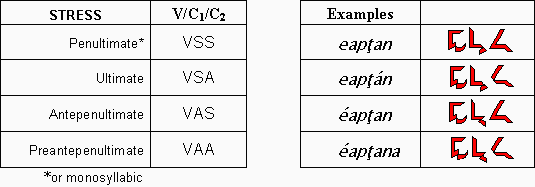
11.4.1.5 Representing Vowels, Mode, and Form. As we have seen elsewhere, the value of any vowel in an Ithkuil formative is completely predictable based on the morphology of the formative itself, with the exception of the vocalic prefixes used to show Affiliation, Extension and Conflation (see Secs. 3.2, 3.4 and 5.4.1 respectively). Therefore, it is unnecessary to represent vowels in a Ithkuil written word except for a character representing the vocalic prefix which also conveys the additional morphological information necessary to determine the vowels to be infixed elsewhere within the stem. Consequently, a written Ithkuil formative will contain only one symbol representing a vowel, and this symbol will indicate the vocalic prefix (if any), as well as the Mode, the Form, the vocalic mutation series, and tone of the word. The details of how this vowel symbol conveys this information is described in the paragraphs below.
There are 24 possible vocalic prefixes to Ithkuil formatives which indicate Affiliation and Extension for nouns or for the first of the seven conflations for verbs. Consequently there are 24 basic vowel characters whose phonetic value corresponds to these prefixes. These 24 characters in turn have an alternate form called the secondary used to indicate the secondary mode of the stem (i.e., corresponding to REPRESENTATIVE essence as per Secs. 2.2.3 and 3.8.1). Both primary and secondary forms in turn have “hook-reversed” forms, i.e., forms identical to the primary and secondary forms, but with the sickle-like hook portion of the character curved in the opposite direction; these hook-reversed forms are used to indicate Form II of the formative, corresponding to the FORMAL designation as explained in Secs. 2.2.3 and 3.7. The alternate and hook-reversed forms added to the 24 primary vowel characters, renders 96 characters. These 96 in turn have eight modifications to indicate the nine mutational series of a stem’s vocalic infix (see Sec. 2.5), resulting in 864 vowel characters. One of these 864 vowel symbols will always be the first character of an Ithkuil written formative. The following table illustrates an example of the basic vowel character ä with its mutations, along with its alternate and hook-reversed forms. Note that, like consonantal characters, the top half of the character carries the distinctions between the nine degrees of mutation.
Primary Form

Primary Form with
Reversed Hook

Secondary Form

Secondary Form with Reversed
Hook

11.4.1.6 Representing Tone.
The four functional tones are indicated by patterns of diacritic dots written
in conjunction with the word-initial vocalic symbol as shown below.
Table 38:
Tone Diacritics

11.4.1.7 Representing Conflation. Conflation is one of the
three morphological categories shown by the initial vocalic prefix to a verbal
formative, the other two being Affiliation and Extension. We have already seen
that the 24 Affiliation/Extension prefixes associated with nouns and the first
Conflation of verbs (the OPERATIVE) is shown by 24 autonomous
characters. The remaining six conflations are shown by a pattern of diacritic
marks placed alongside the vocalic prefix and the two consonantal radical characters.
The diacritic itself is a wedge-shaped mark (![]() ) which changes to a short bar (
) which changes to a short bar ( ![]() or
or ![]() ) if replacing
a diacritic dot (indicating Pattern, Stem or Tone) already present. The pattern
is as follows:
) if replacing
a diacritic dot (indicating Pattern, Stem or Tone) already present. The pattern
is as follows:
Table 39: Diacritic Markings
for Displaying Conflation

11.4.1.8 Representing Affixes. Although every
affix to a formative generally has both a prefix and a suffix form, only the
suffix form is represented in the Ithkuil writing system, i.e., any consonantal
prefix to a formative in the spoken language appears as a suffix in the written
language. As detailed in Chapter 7,
the suffix consists of a consonant preceded by a vowel determined by one of
three affix-types and one of nine degrees. In writing, the 60 C1/C2
characters are used to represent these affixes, each with its own independent
consonantal value when used as an affix. In other words, the phonemic value
associated with these 60 symbols when written as a suffix is independent of
their value when written as a C1 or C2
radical. As with C1 and C2 representations,
the reader’s clue to interpreting the symbol as an affix is by position
within the word; the suffix will always be the third (or more) consonantal symbol
in a word. Note that affixes which contain geminated (i.e., doubled) consonants
(e.g., mm,
ss,
tt,
etc.) are shown by the character corresponding to their ungeminated form plus
an additional underposed dot, e.g., n ![]() nn
nn
![]() .
.
Affix Degree. The nine affixual degrees associated with a given consonantal affix category are represented by the same character mutations used to show the nine grades of C1/C2 mutation.
Affix-Type. Affixes containing Type-1 vocalic infixes are unmarked. Affixes having Type-2 vocalic infixes are marked with a diacritic dot alongside the letter. Affixes having Type-3 vocalic infixes are marked with the wedge-shaped diacritic mark alongside the character (the same mark used with C1/C2 radical characters to show conflation). If a Type-3 affix character is geminated, this gemination may be shown by modifying the wedge-diacritic to a short bar (as explained above for Conflation) and deleting the underposed dot usually used for gemination.
11.4.1.9 Representing Focus. POSITIVE
focus is shown by placing a special diacritic, an underposed vertical bar ![]() under any available character in the word.
under any available character in the word.
11.4.1.10 Representing Illocution. In Sec.
5.1 we saw that Ithkuil indicates the morphological category of Illocution
primarily by a consonantal infix between the word-initial vocalic prefix and
the C1 consonantal radical. However, in Sec. 7.7.13 we
saw an alternative method of conveying Illocution using the ILL
suffix -V2![]() ,
used when the infixed form is not phonologically permissible. Generally, the
Ithkuil script conveys only the suffixed form. An exception is made however,
for the DIRECTIVE illocution, for which an optional “shortcut”
notation exists, consisting of placing a special diacritic, a horizontal bar
,
used when the infixed form is not phonologically permissible. Generally, the
Ithkuil script conveys only the suffixed form. An exception is made however,
for the DIRECTIVE illocution, for which an optional “shortcut”
notation exists, consisting of placing a special diacritic, a horizontal bar
![]() under the C1 character.
under the C1 character.
The rules for writing aspectual adjuncts and personal reference adjuncts in Ithkuil script are distinct from writing formatives, employing a different type of written symbol, specifically “composite” characters made up of three separate character elements. Note that other adjuncts such as combination adjuncts and affixual adjuncts are not represented autonomously in the Ithkuil writing system, as these adjuncts exist purely for euphonic and phonotactical considerations which are either optional, or where not optional, predictable. Since combination and affixual adjuncts are alternative formats for more standard morpho-phonological representations of these categories, they are always represented in their standard formatting when written, regardless of how they are interpreted in the spoken language.
11.4.2.1 Aspectual Adjuncts. These take the written form of VP(Cb)CX, where the first VP represents the word-initial vocalic prefix indicating aspect, Cb represents a Bias suffix from Sec. 6.6.1 represented by a C1/C2 character carrying its C1 phonological value (with the glottal stop portion of the bias suffix is not represented), and the final CX represents a specialized composite character explained below. Stress and tone (indicating Mood) are shown by a specialized diacritic explained later below. VP utilizes primary vowel forms in both standard and hook-reversed forms, depending on the specific phonological value of the vowel or diphthong. Any second aspect shown in the adjunct is indicated by the VP character as well, by means of its various mutations and secondary forms, as follows: Series 2 through 9 of the primary character represent additional aspects 1 through 8 as shown in Table 19 of Sec. 6.4.1; Series 2 through 9 of the secondary form of the character indicate additional aspects 9 through 16; Series 2 through 9 of the primary character plus an underposed dot indicate additional aspect 17 through 24; Series 2 through 9 of the secondary form of the character plus underposed dot indicate additional aspects 25-32.
As detailed in Chapter 6, the CX consonantal infix of an aspectual adjunct synthetically represents the three morphological categories of Validation, Phase, and Sanction. Each of these categories contain nine possible values for a total of 93 combinations, i.e., 789 possible infixes. Rather than create 789 autonomous symbols to represent CX, Ithkuil utilizes 27 character components (nine representing Validation, nine representing Phase, nine representing Sanction) which are then combined into one tripartite composite character. The general physical structure of this composite character is as follows:

These twenty-seven component elements are shown below along
with three example composite characters, ![]() .
.
Tables 40, 41 and 42: Components
for Written Validation-Phase-Sanction Symbols
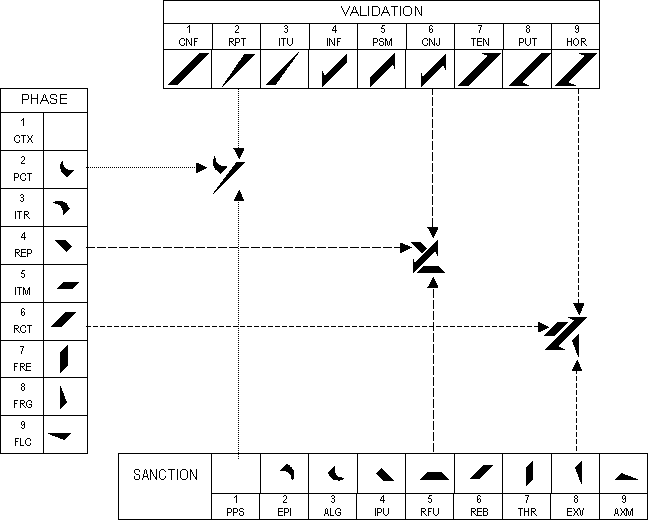
Stress and tone on an aspectual adjunct, indicating Mood, are shown by varied
patterns of diacritic dots on the tripartite composite character, as per the
following examples using the composite character ![]() .
.
Table 43:
Mood Diacritics

11.4.2.2 Personal Reference Adjuncts. As described in Sec. 8.1, these are of two types: single-referent and dual-referent. Single-referent adjuncts have both a short form and a long form. The form of dual-referent adjuncts is identical to the long form of the single-referent adjunct, with the addition of suffixed elements. When representing these adjuncts in writing, it is always the long form of the adjunct that is represented, regardless of whether the speaker chooses to pronounce it as the short form. The morphological elements of this long form are represented by the following combined formula, whose elements are described in the list below:
(
+)
+
+(VB+Cw(+Ve (+Cb)))
![]() = optional vocalic prefix indicating the Configuration, Affiliation, Designation,
Focus and Essence of Referent 1, the values of which are given in Table
25 from Sec. 8.1.2 and Table
28 in Sec. 8.1.3.
= optional vocalic prefix indicating the Configuration, Affiliation, Designation,
Focus and Essence of Referent 1, the values of which are given in Table
25 from Sec. 8.1.2 and Table
28 in Sec. 8.1.3.
![]() = the single or dual personal-referent consonantal infix from Sec.
8.1.3, Table 30.
= the single or dual personal-referent consonantal infix from Sec.
8.1.3, Table 30.
![]() = the vocalic case infix for Referent 1, as described in Section
8.1.2 and whose values are summarized in Table 24 in that Section.
= the vocalic case infix for Referent 1, as described in Section
8.1.2 and whose values are summarized in Table 24 in that Section.
VB
= a vocalic infix indicating either the Designation and Context of Referent
2 (labeled ![]() in Sec. 8.1.3)
in a dual-referent adjunct, OR a vocalic
suffix indicating the Context of Referent 1 in a single-referent adjunct (labeled
in Sec. 8.1.3)
in a dual-referent adjunct, OR a vocalic
suffix indicating the Context of Referent 1 in a single-referent adjunct (labeled
![]() in Sec. 8.1.2),
OR the degree and affix-type of a formative
suffix in a single-referent adjunct (labeled
in Sec. 8.1.2),
OR the degree and affix-type of a formative
suffix in a single-referent adjunct (labeled ![]() in Sec. 8.1.2).
in Sec. 8.1.2).
Cw
= a consonantal form representing either the consonantal case infix and Affiliation
for Referent 2 (described as ![]() in Section 8.1.3 with values given in Table
31) in a dual-referent adjunct, OR
the consonantal formative suffix of a Form 3 single-referent adjunct as described
in Sec. 8.1.2 and
labeled
in Section 8.1.3 with values given in Table
31) in a dual-referent adjunct, OR
the consonantal formative suffix of a Form 3 single-referent adjunct as described
in Sec. 8.1.2 and
labeled ![]() .
.
Ve
= a vocalic affix either showing the Context for Referent 1 in a single-referent
adjunct (labelled ![]() in Sec. 8.1.2)
or showing Affiliation for Referent 2 in a dual-referent adjunct (labelled
in Sec. 8.1.2)
or showing Affiliation for Referent 2 in a dual-referent adjunct (labelled ![]() in Sec. 8.1.3).
in Sec. 8.1.3).
Cb
= one of the 48 consonantal Bias affixes from Table 20 in Sec.
6.6.1.
The above combined formula, when represented in Ithkuil script,
is written as (![]() )
)![]()
![]() (Cw(Cb)),
where each character is written as follows:
(Cw(Cb)),
where each character is written as follows:
![]() utilizes the characters for a, e, u
and i used with formatives depending on which of the four affiliations
is required, the nine mutations of each being used to show Configuration and;
for FORMAL designation, the hook-reversed forms of the
four vowel characters are used; for INFORMAL designation
plus POSITIVE focus, the characters for â,
ê, û and î
are used, their hook-reversed forms indicating FORMAL
designation. For REPRESENTATIVE essence, the above patterns
are used but with the vowel character in its secondary form.
utilizes the characters for a, e, u
and i used with formatives depending on which of the four affiliations
is required, the nine mutations of each being used to show Configuration and;
for FORMAL designation, the hook-reversed forms of the
four vowel characters are used; for INFORMAL designation
plus POSITIVE focus, the characters for â,
ê, û and î
are used, their hook-reversed forms indicating FORMAL
designation. For REPRESENTATIVE essence, the above patterns
are used but with the vowel character in its secondary form.
![]() utilizes the 60 C1/C2 consonantal
characters (in all nine degrees) interpreted as having their C1
phonological value for each degree (e.g., the
utilizes the 60 C1/C2 consonantal
characters (in all nine degrees) interpreted as having their C1
phonological value for each degree (e.g., the ![]() value -xt-,
equivalent to x+ç,
would be written using the 5th degree mutation of the C1
character for kt,
whose value is xt).
value -xt-,
equivalent to x+ç,
would be written using the 5th degree mutation of the C1
character for kt,
whose value is xt).
Before discussing the ![]() +
VB
character, we will discuss the representation of Cw,
Ve
and Cb.
+
VB
character, we will discuss the representation of Cw,
Ve
and Cb.
The Cw
character utilizes the 60 C1/C2
consonantal characters but interpreted as having their C2
phonological value, unless the alternate form of the character is used, in which
case it has its C1 phonological value. The nine mutations
of which are used to represent either the Configuration of Referent 2, or the
affix-type of the formative suffix ![]() (using mutations 1, 2, and 3). Note that if
(using mutations 1, 2, and 3). Note that if ![]() is a glottal stop it is represented by an underposed dot to the
is a glottal stop it is represented by an underposed dot to the ![]() character rather than by a Cw
character.
character rather than by a Cw
character.
Ve
is shown via the Cw
character, as follows: C =
a, C![]() = u, C
= u, C![]() = â, C
= â, C![]() = û.
= û.
Cb is shown via the 60 C1/C2 characters, interpreted as having their C1 phonological value
Stress is shown via the ![]() character as follows: penultimate stress is unmarked; ultimate stress is shown
by employing the alternate form of the
character as follows: penultimate stress is unmarked; ultimate stress is shown
by employing the alternate form of the ![]() character; antepenultimate stress is indicated by an underposed dot; preantepenultimate
stress by a combination of alternate form of the character and an underposed
dot.
character; antepenultimate stress is indicated by an underposed dot; preantepenultimate
stress by a combination of alternate form of the character and an underposed
dot.
Tone is indicated in the written personal reference adjunct
by means of the diacritic pattern from Sec. 11.4.1.6
above, applied to the initial ![]() character; in the absence of a
character; in the absence of a ![]() character, tone is indicated on the
character, tone is indicated on the ![]() character using the following diacritics: C
= falling,
C
character using the following diacritics: C
= falling,
C![]() = high,
C
= high,
C![]() = rising,
C
= rising,
C![]() = broken.
= broken.
![]() +
VB
is represented by a specialized vocalic character used only in personal reference
adjuncts. It consists of an upper and lower set of symbols which are essentially
a counting system indicating one of the 81 cases (see Chapter
4). The two sets of symbols are bifurcated by one of nine horizontal bar-like
elements which represent VB
(NOTE: when VB
represents Vz
from Sec. 8.1.2,
only the first four of the nine bar elements are used). These symbols are shown
below along with a diagram showing the composition of three example
+
VB
is represented by a specialized vocalic character used only in personal reference
adjuncts. It consists of an upper and lower set of symbols which are essentially
a counting system indicating one of the 81 cases (see Chapter
4). The two sets of symbols are bifurcated by one of nine horizontal bar-like
elements which represent VB
(NOTE: when VB
represents Vz
from Sec. 8.1.2,
only the first four of the nine bar elements are used). These symbols are shown
below along with a diagram showing the composition of three example ![]() +
VB
characters, respectively Case 1 with VB
=1, Case 23 with VB
= 5, and Case 50 with VB
= 8.
+
VB
characters, respectively Case 1 with VB
=1, Case 23 with VB
= 5, and Case 50 with VB
= 8.
Tables 44,
45 and 46: Components of Specialized Personal Reference Adjunct Symbols

11.4.2.3 Valence/Version/Conflation Adjuncts.
These are written per the formula (Vm)(CN)CV
where Vm
is the vocalic modality suffix from Sec.
5.5, CN
is the consonantal derivation prefix from Sec.
5.4.3, and CV
is a specialized character indicating both valence and version as per the table
below. Vm
is written using standard primary vowel characters; the use of secondary forms
indicates positive focus; the four tones indicated by series A through D mutational
forms. CN
is written using the 60 C1/C2 characters
with their C1 phonological value. In the absence of a
Vm
character, POSITIVE focus is shown using the alternate
form of the CN
character, while tone is shown by the first four mutational grades of the CN
character. Also, the CN
character may take an underposed bar diacritic ( ![]() ) in the absence of Vm
in order to disambiguate it as being the suffix of a preceding formative. In
the absence of both a Vm
and CN
character, marked tone and focus can be shown using a placeholder Vm
character, the symbol for the ae
diphthong which otherwise does not occur with such adjuncts.
) in the absence of Vm
in order to disambiguate it as being the suffix of a preceding formative. In
the absence of both a Vm
and CN
character, marked tone and focus can be shown using a placeholder Vm
character, the symbol for the ae
diphthong which otherwise does not occur with such adjuncts.
Table 47:
Valence + Version Characters
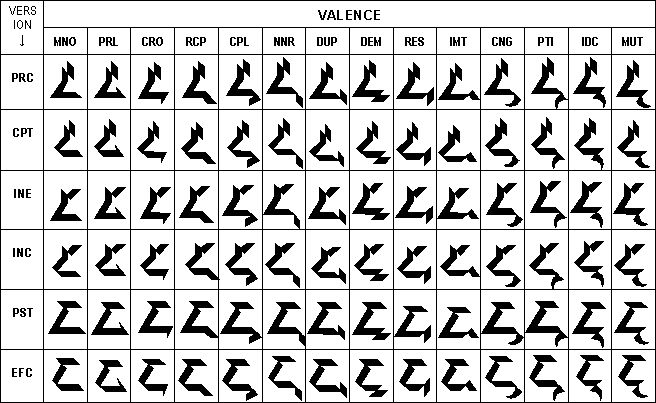
Format (Sec. 5.4.2) is shown via diacritics to the above valence/version character, as follows:
Table 48:
Format Diacritics

Because all formatives begin with a vowel symbol, and all written adjuncts contain a specialized character, it is always possible to determine where new words begin in a line of Ithkuil writing, obviating the need for a blank space or other boundary between words. In turn, a blank space functions to indicate a sentence boundary. And because Ithkuil morphology already indicates within words themselves various attitudes, moods, and other information which are normally indicated supra-segmentally in Western languages (e.g., by tone or inflection of the voice, hyper-enunciation, etc.), symbols such as exclamation points and question marks are likewise unnecessary. The only “punctuation” symbols used are to show quotations of direct speech and phonetic transliteration (as when spelling non-Ithkuil words and names). These two sets of symbols are shown below. Note that the quotation marks are used only to indicate direct speech; they are not used as in English to offset a word for emphasis or special usage. The phonetic rendering marks indicate the word or phrase between the marks is to be pronounced phonetically (i.e., alphabetically). When writing alphabetically, consonantal characters carry their C1 phonetic value; C2 phonetic values are shown by an underposed dot. The secondary form of vowels are used to indicate the stressed syllable. If desired, tone may be indicated on vowels using the same diacritic markings as shown in Sec. 11.4.1.6 above.
[insert quote here]
[word to be pronounced alphabetically]
The following tables detail the characters of the Ithkuil script
along with the various phonemic values assigned to the symbol depending on the
character’s function within the word. The specific usages of the various
sets of vowels, their secondary forms, their hook-reversed forms, and the primary
versus secondary forms of consonant characters have been previously explained
above in Section 11.4.1 and its various sub-sections.
Table 49: SET 1 VOWEL CHARACTERS

Table 50: SET 1 SECONDARY
FORMS

Table 51: SET 1 HOOK-REVERSED
FORMS
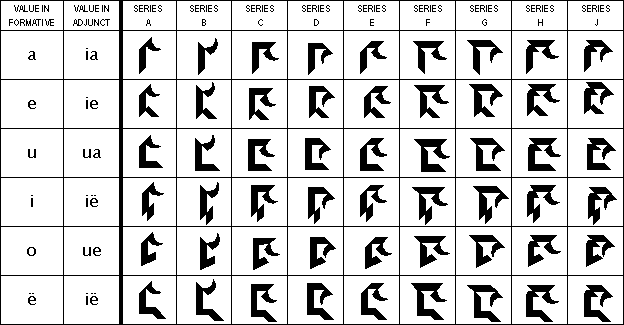
Table 52: SET 1 SECONDARY
HOOK-REVERSED FORMS

Table 53: SET 2 VOWEL CHARACTERS
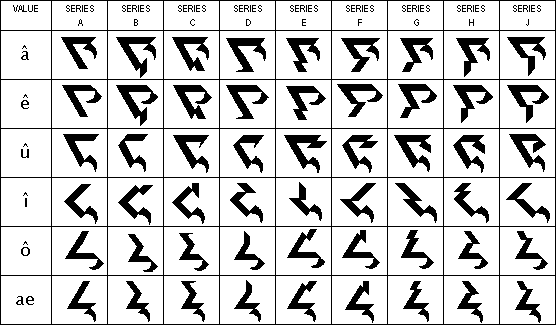
Table 54: SET 2 SECONDARY
FORMS
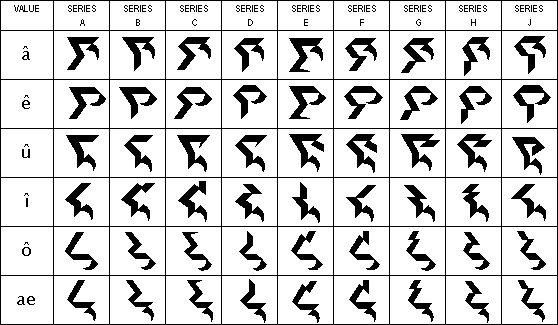
Table 55: SET 2 HOOK-REVERSED
FORMS

Table 56: SET 2 SECONDARY
HOOK-REVERSED FORMS
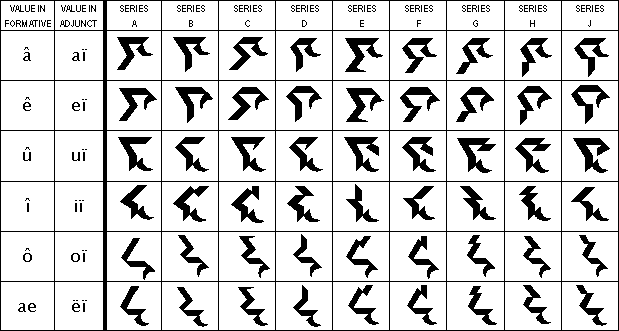
Table 57: SET 3 VOWEL CHARACTERS
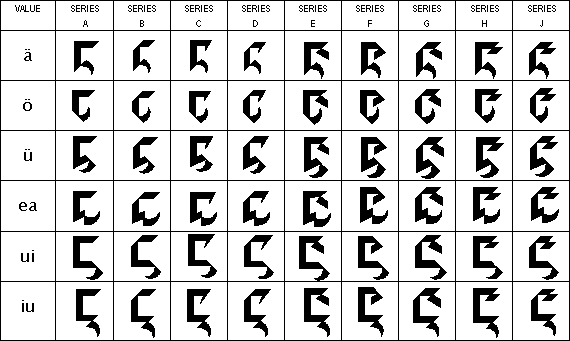
Table 58: SET 3 SECONDARY
FORMS
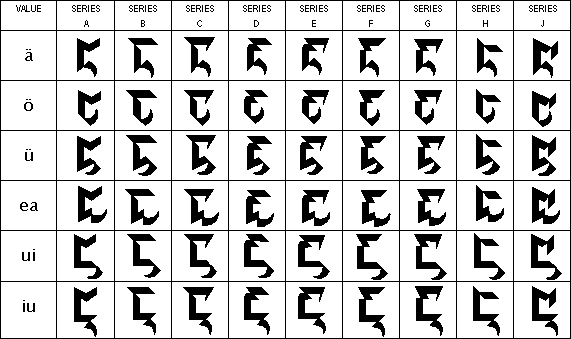
Table 59: SET 3 HOOK-REVERSED
FORMS
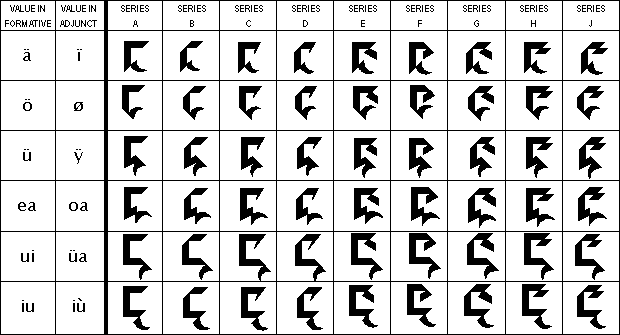
Table 60: SET 3 SECONDARY
HOOK-REVERSED FORMS
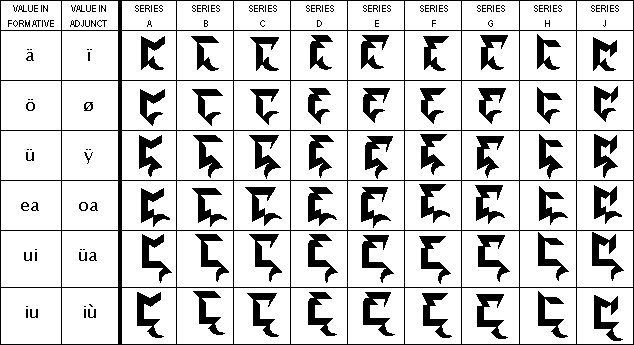
Table 61: SET 4 VOWEL CHARACTERS
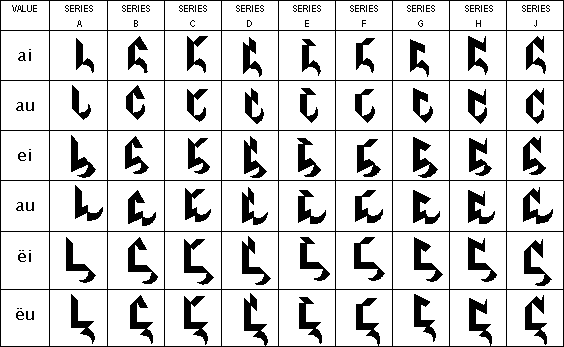
Table 62: SET 4 SECONDARY
FORMS
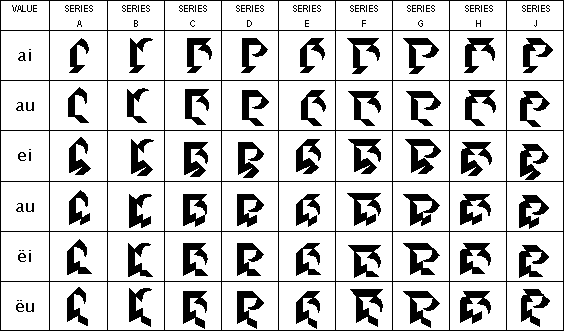
Table 63: SET 4 HOOK-REVERSED
FORMS
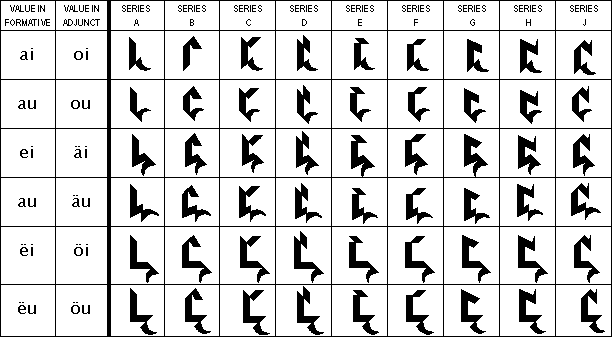
Table 64: SET 4 SECONDARY
HOOK-REVERSED FORMS
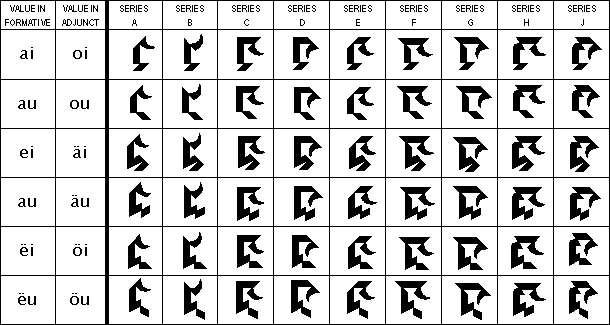
Table 65: PRIMARY CONSONANT
SYMBOLS
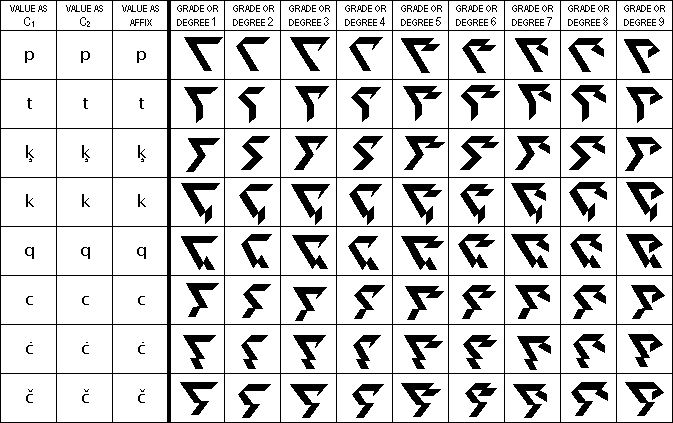
Table 65(continued): PRIMARY
CONSONANT SYMBOLS
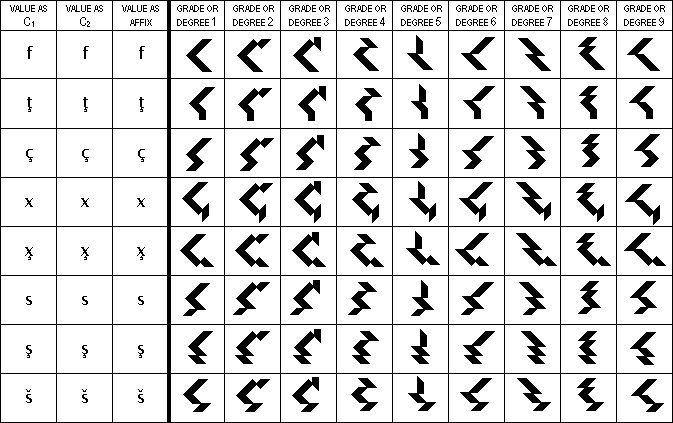
Table 65(continued): PRIMARY
CONSONANT SYMBOLS
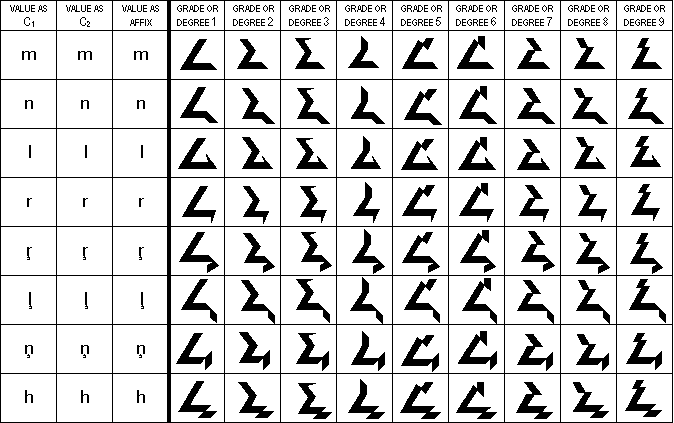
Table 65(continued): PRIMARY
CONSONANT SYMBOLS
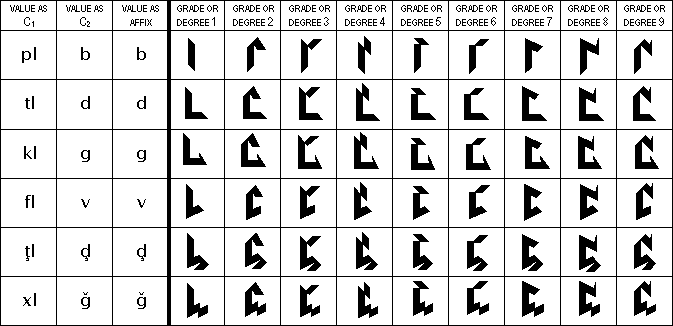
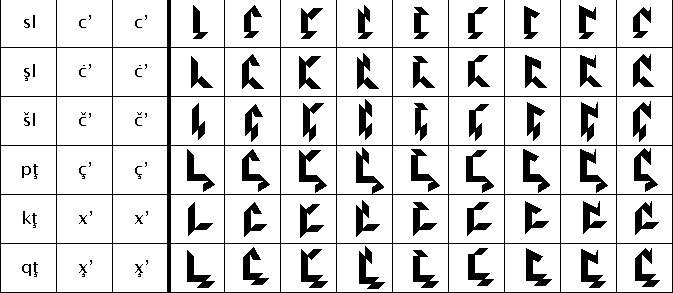
Table 65(continued): PRIMARY
CONSONANT SYMBOLS
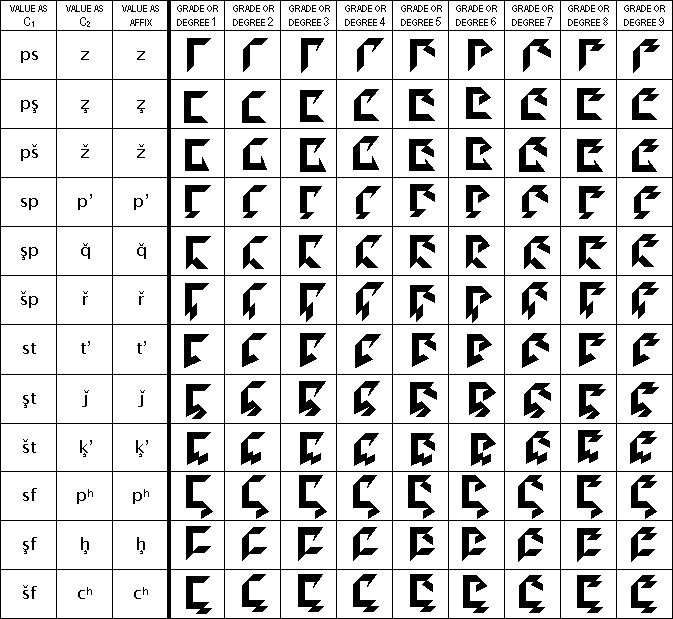
Table 65(continued): PRIMARY
CONSONANT SYMBOLS
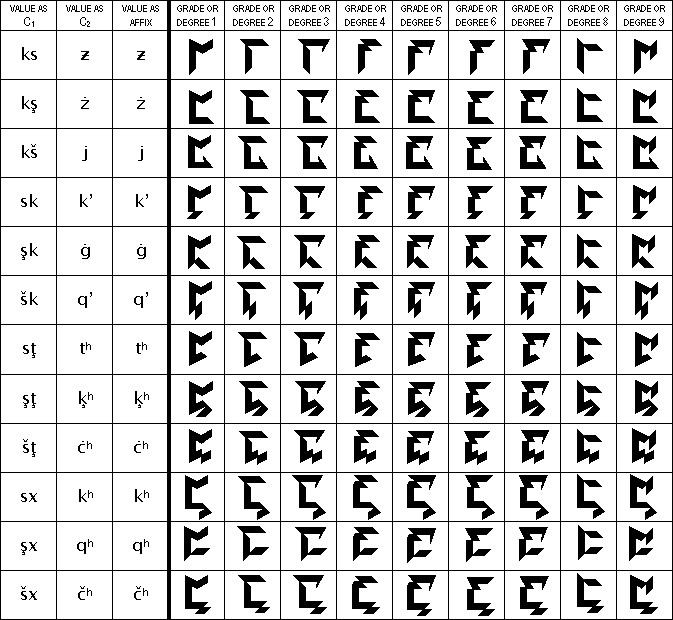
Table 66: ALTERNATE CONSONANT
SYMBOLS
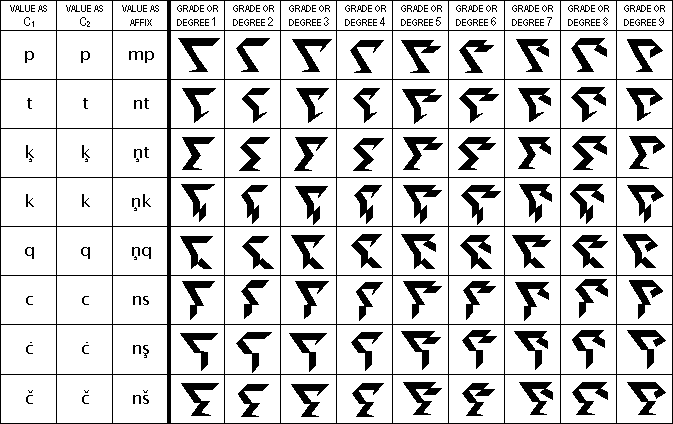
Table 66 (continued): ALTERNATE
CONSONANT SYMBOLS
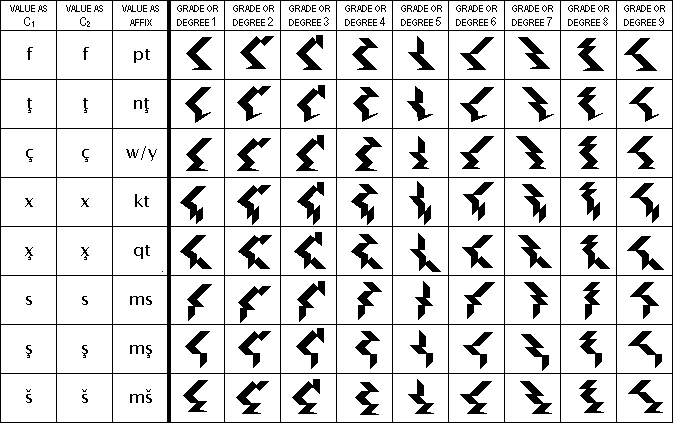
Table 66 (continued): ALTERNATE
CONSONANT SYMBOLS
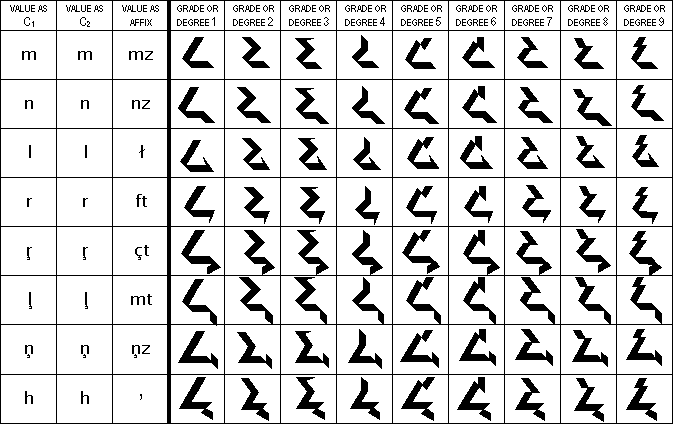
Table 66 (continued): ALTERNATE
CONSONANT SYMBOLS
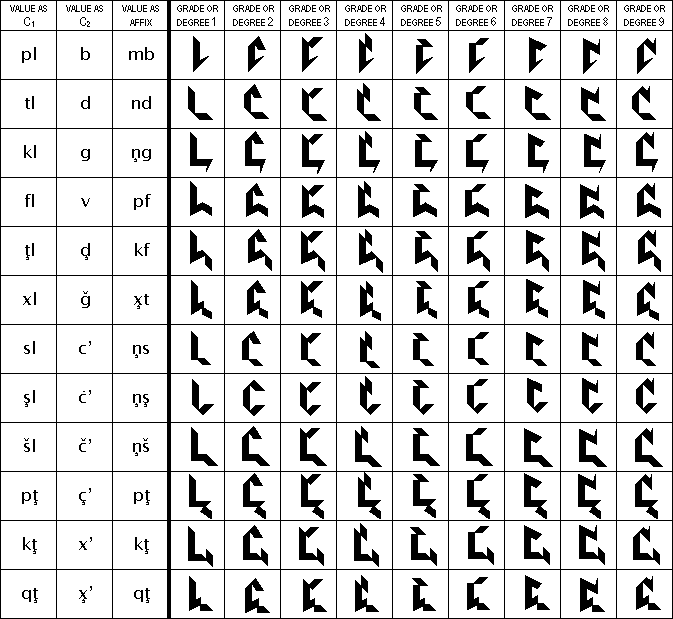
Table 66 (continued): ALTERNATE
CONSONANT SYMBOLS
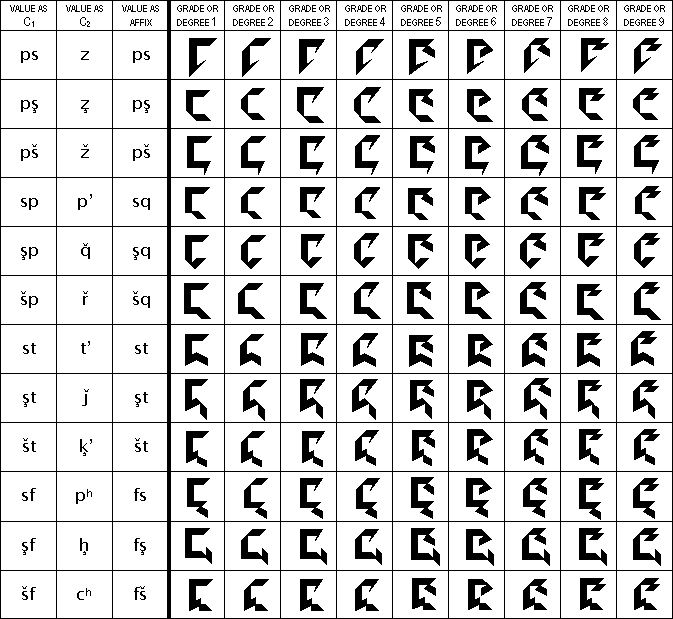
Table 66 (continued): ALTERNATE
CONSONANT SYMBOLS

Proceed
to Chapter 12: The Number System >>
| 2 Morpho-Phonology | 7a Using Affixes | 12 The Number System | |
| 3 Basic Morphology | 7b Using Affixes (continued) | The Lexicon | |
| 4 Case Morphology | 8 Adjuncts | Revised Ithkuil: Ilaksh |
©2004-2009 by John Quijada. You may copy or excerpt any portion of the contents of this website provided you give full attribution to the author and this website.